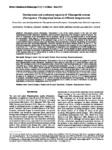Use este identificador para citar ou linkar para este item:
http://www.alice.cnptia.embrapa.br/alice/handle/doc/1021651Registro completo de metadados
| Campo DC | Valor | Idioma |
|---|---|---|
| dc.contributor.author | FONSECA, A. R. | pt_BR |
| dc.contributor.author | CARVALHO, C. F. | pt_BR |
| dc.contributor.author | CRUZ, I. | pt_BR |
| dc.contributor.author | SOUZA, B. | pt_BR |
| dc.contributor.author | ECOLE, C. C. | pt_BR |
| dc.date.accessioned | 2015-08-10T11:11:11Z | pt_BR |
| dc.date.available | 2015-08-10T11:11:11Z | pt_BR |
| dc.date.created | 2015-08-10 | pt_BR |
| dc.date.issued | 2015 | pt_BR |
| dc.identifier.citation | Revista Colombiana de Entomología, Bogotá, v. 41, n. 1, p. 5-11, enero/jun. 2015. | pt_BR |
| dc.identifier.uri | http://www.alice.cnptia.embrapa.br/alice/handle/doc/1021651 | pt_BR |
| dc.description | Chrysoperla externa (Neuroptera: Chrysopidae) is one of the natural enemies of the corn leaf aphid Rhopalosiphum maidis (Hemiptera: Aphididae) and has potential application in the biological control of that pest. The effect of? temperature on the development and the predatory capacity of this chrysopid fed with R. maidis nymphs was investigated. Fresh eggs of C. externa were maintained at 15, 20, 25 or 30 °C under 70% relative humidity and 12 h photophase, and the duration of the embryonic stage, as well as the duration and viability of the larval (first, second and third instars), prepupal, pupal and adult forms of the predator were evaluated. The duration of each of these stages decreased with increasing temperature, whilst the viabilities of all forms attained 100% at 20 and 25 °C. The threshold temperature and the value of the thermal constant K obtained for the complete life cycle (egg to adult) were, respectively, 10.7 °C and 377.8 degree-days. Independent of temperature, the consumption of R. maidis nymphs by C. externa increased as the larvae reached maturity. At 20 and 25 °C the average number of aphids consumed during the complete larval stage was maximal at approximately 350 specimens. It is concluded, therefore, that the development of the immature forms of C. externa fed on R. maidis as well as its viability and predatory capacity, were favored at temperatures between 20 and 25 °C. | pt_BR |
| dc.language.iso | eng | eng |
| dc.rights | openAccess | eng |
| dc.subject | Corn leaf aphid | pt_BR |
| dc.subject | Predator | pt_BR |
| dc.subject | Green lacewing | pt_BR |
| dc.subject | Thermal requirements | pt_BR |
| dc.title | Development and predatory capacity of Chrysoperla externa (Neuroptera: Chrysopidae) larvae at different temperatures. | pt_BR |
| dc.type | Artigo de periódico | pt_BR |
| dc.date.updated | 2016-03-04T11:11:11Z | pt_BR |
| dc.subject.thesagro | Controle biológico | pt_BR |
| dc.subject.nalthesaurus | Biological control | pt_BR |
| riaa.ainfo.id | 1021651 | pt_BR |
| riaa.ainfo.lastupdate | 2016-03-04 | pt_BR |
| dc.contributor.institution | ALYSSON R. FONSECA, UEMG; CÉSAR F. CARVALHO, UFLA, Lavras, MG.; IVAN CRUZ, CNPMS; BRÍGIDA SOUZA, UFLA, Lavras, MG.; CARLOS C. ECOLE, (IIAM), Mavalane, Maputo, Mozambique. | pt_BR |
| Aparece nas coleções: | Artigo em periódico indexado (CNPMS)  | |
Arquivos associados a este item:
| Arquivo | Descrição | Tamanho | Formato | |
|---|---|---|---|---|
| Developmentpredatory.pdf | 431,85 kB | Adobe PDF |  Visualizar/Abrir |









